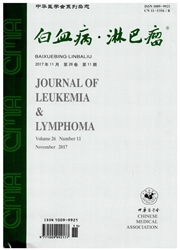

 中文摘要:
中文摘要:
目的探讨急性髓系白血病(AML)(非M3)患者化疗后骨髓油滴和巨核细胞数变化规律及其预后意义。方法对99例初诊AML(非M3)患者资料进行回顾性分析,评价规范治疗各阶段骨髓油滴及巨核细胞数变化及其对总体生存(OS)率、无病生存(DFS)率的影响。结果99例患者中位DFS为21个月(2~88个月),3年DFS率为47.3%,中位OS70个月(4~89个月),3年OS率55.8%。诱导化疗达完全缓解(CR)后骨髓油滴数随着诱导缓解后化疗次数增加呈增加趋势,而巨核细胞数呈减少趋势。将单因素分析提示有意义的诱导缓解后第2次化疗后巨核细胞数变化率、诱导缓解后第1—3次化疗后骨髓油滴变化、骨髓纤维化分级、初诊乳酸脱氢酶值、白血病细胞免疫分型、起病时骨髓白血病细胞比例及诱导化疗结束后第7天至第10天残留白血病细胞比例等观察指标纳入多因素分析,结果提示起病时骨髓白血病细胞比例小于50%、诱导缓解后第3次化疗后骨髓油滴较诱导化疗CR期增多对于延长患者DFS时间有独立预后意义(P=0.010、0.018);而诱导化疗结束后第7天至第10天残留白血病细胞比例≥10%及诱导缓解后第2次化疗后骨髓巨核细胞数变化率≤一50%为OS的独立不良预后因素(P=0.009、0.038)。结论AML(非M3)患者达CR后,随着诱导缓解后化疗次数增加骨髓油滴呈增加趋势,而巨核细胞数呈减少趋势。动态观察骨髓油滴及巨核细胞计数有助于患者预后判断。
 英文摘要:
英文摘要:
Objective To investigate the changes and prognostic significanc, e of bone marrow(BM) oil drop and megakaryocyte counts after chemotherapy in acute myeloid leukemia (AML) patients (non-M3). Methods Ninty-nine adult patients with denovo AML (non-M3) were retrospectively analyzed to evaluate the change of BM oil drop and megakaryocyte counts and their influences on overall survival(OS) and disease free survival (DFS) during all stages of standardized therapy. Results The median DFS and OS were 21 (2-88) months and 70 (4-89) months, respectively; and 3-year predicted DFS and OS were 47.3 % and 55.8 %, respectively. After AML patients (non-M3) achieving complete remission (CR) by induction therapy, BM oil drop tended to increase along with postremission chemotherapy cycle accumulation, while megakaryocyte counts tended to decrease. The univariate analysis indicated that megakaryocyte counts decreased after the second course of postremission therapy. BM oil drop increased after the first to the third course of postremission therapy. Grade of myelofibrosis in BM biopsy, serum lactate dehydrogenase (LDH) level at diagnosis, flow cytometric immunophenotyping, the percentage of BM blast cells at diagnosis and the percentage of residual leukemic cells (RLC) during aplasia (7-10 days after the end of induction therapy) had prognostic significance. Multivariable COX analysis indicated the percentage of BM blast cells at diagnosis and change of BM oil drop after the third postremission therapy were independent prognostic factors for DFS (P = 0.010, 0.018 respectively), and RLCs during aplasia and change rate of the megakaryocyte counts after the second postremission therapy were independent prognostic factors for OS (P = 0.009, 0.038 respectively). Conclusion After AML patients (non-M3) achieving CR by induction therapy, BM oil drop tends to increase along with postremission chemotherapy cycles accumulation, while the megakaryocyte counts tend to decrease. Dynami
 同期刊论文项目
同期刊论文项目
 同项目期刊论文
同项目期刊论文
 RAD51 and XRCC3 polymorphisms: Impact on the risk and treatment outcomes of de novo inv(16) or t(16;
RAD51 and XRCC3 polymorphisms: Impact on the risk and treatment outcomes of de novo inv(16) or t(16; Stress hematopoiesis reveals abnormal control of self-renewal, lineage bias, and myeloid differentia
Stress hematopoiesis reveals abnormal control of self-renewal, lineage bias, and myeloid differentia Clinical importance of SF3B1 mutations in Chinese with myelodysplastic syndromes with ring siderobla
Clinical importance of SF3B1 mutations in Chinese with myelodysplastic syndromes with ring siderobla ~JAK2V617F allele burden, JAK2 46/1 haplotype and clinical features of Chinese with myeloproliferati
~JAK2V617F allele burden, JAK2 46/1 haplotype and clinical features of Chinese with myeloproliferati Serum Ferritin Is an Independent Prognostic Factor in Chinese with Myelodysplastic Syndromes Classif
Serum Ferritin Is an Independent Prognostic Factor in Chinese with Myelodysplastic Syndromes Classif Polymorphisms in folate-related genes: impact on risk of adult acute lymphoblastic leukemia rather t
Polymorphisms in folate-related genes: impact on risk of adult acute lymphoblastic leukemia rather t 期刊信息
期刊信息
